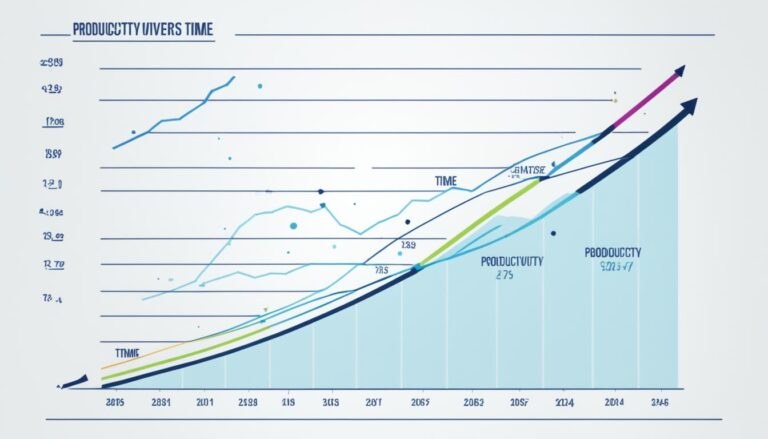Boost Your Output: Productivity is Defined as the Quantity of

Have you ever wondered what productivity truly means? Is it simply about working longer hours or completing more tasks? Or is there something more to it? In today’s fast-paced world, understanding the definition and measurement of productivity is essential for individuals and organizations striving to maximize their output.
In economics, productivity goes beyond mere quantity. It refers to how much output can be produced with a given set of inputs. In other words, productivity is about achieving more with the same resources or achieving the same results with fewer resources. But how exactly is productivity measured, and what factors influence its growth?
Join us as we explore the fascinating world of productivity and delve into the various aspects that shape it. From understanding the different types of productivity to exploring strategies for improving productivity in the workplace, we will equip you with the knowledge and insights to boost your own output and achieve greater success.
Key Takeaways:
- Productivity is defined as the ability to produce more output with the same inputs or the same output with fewer inputs.
- There are two main types of productivity measures: labor productivity and multifactor productivity.
- Productivity can be influenced by efficiency improvements, expanding productive capacity, and spillover effects between businesses.
- Higher productivity leads to benefits such as higher wages, lower prices, and increased profits.
- Measuring productivity in the workplace involves comparing output to input, using formulas and productivity measures.
How is Productivity Measured?
In order to understand and improve productivity, it is essential to have effective methods of measuring it. In Australia, the Australian Bureau of Statistics (ABS) employs various productivity metrics to assess and evaluate productivity levels. By calculating the ratio of output to inputs, the ABS provides valuable insights into the efficiency and effectiveness of economic activities.
Output, as measured by the ABS, is defined as the quantity of goods and services produced within a specified time frame. This is typically evaluated using the gross value added (GVA) method, which accounts for the overall value created by different sectors of the economy. By analyzing the GVA, policymakers and businesses gain an understanding of the quantity and value of the output generated.
Inputs, on the other hand, encompass the factors that contribute to the production process. The two primary inputs considered by the ABS are labor and capital. Labor input can be measured in terms of the number of hours worked or the number of employed persons, allowing for comparisons and assessments of workforce productivity. Capital input, on the other hand, quantifies the value of productive assets employed by businesses, providing insights into the efficiency of capital utilization.
Measuring productivity, however, does present challenges. For instance, certain industries, particularly non-market sectors such as healthcare and public administration, may pose difficulties in accurately quantifying their output. Additionally, some inputs and outputs may be excluded from measurement due to limitations in data availability or methodological constraints.
Overall, productivity measurement plays a critical role in understanding the efficiency and performance of economic activities. By analyzing and interpreting productivity metrics, policymakers and businesses can identify areas for improvement, implement targeted strategies, and drive economic growth.
The following table provides an overview of the productivity factors considered by the ABS:
| Productivity Factors |
|---|
| Labor input |
| Capital input |
| Output quantity |
| Non-market output challenges |
| Data limitations |

What Drives Productivity Growth?
To achieve sustainable growth and success, it is crucial to identify the key drivers of productivity growth. By implementing effective strategies, businesses and individuals can increase productivity, boost output, and achieve their goals. Let’s explore some of the strategies that can drive productivity growth:
Efficiency Improvements
Operating more efficiently is essential for increasing productivity. By optimizing processes, eliminating bottlenecks, and reducing waste, you can achieve technical efficiency. This means producing more output without sacrificing the production of another good or service. Microeconomic reforms and improvements in management practices can play a significant role in enhancing efficiency.
Expanding Productive Capacity
Innovation and advances in technology are the catalysts for expanding productive capacity. By investing in research and development, adopting new technologies, and encouraging creativity and innovation, businesses can increase their potential for production. Expanding productive capacity creates opportunities for growth and drives productivity improvement.
Spillover Effects
Productivity growth can also be influenced by spillover effects between businesses, such as the sharing of knowledge and innovation. Collaboration, partnerships, and networking can foster an environment of learning and exchange, leading to productivity gains for all involved parties.

Implementing these productivity improvement strategies can have a significant impact on your overall productivity. By focusing on efficiency, expanding capacity, and fostering collaboration, you can drive productivity growth and achieve remarkable results.
| Benefits of Productivity Growth | Productivity Improvement Strategies |
|---|---|
| Higher wages for workers | Efficiency improvements |
| Lower prices for consumers | Innovating and utilizing new technologies |
| Increased profits for businesses | Collaborating and sharing knowledge |
By embracing productivity improvement strategies, individuals, businesses, and economies can unlock their full potential and achieve long-term success. It is through these efforts that we can continuously strive for greater efficiency, innovation, and productivity, leading to a prosperous future.
Benefits of Productivity Growth
Productivity growth is essential for achieving economic prosperity and improving overall welfare. When productivity increases, it brings forth a range of benefits that positively impact workers, consumers, and businesses alike.
Higher Wages for Workers
Increased productivity allows businesses to generate more output with the same amount of work or resources. As a result, companies can distribute higher wages to their employees, rewarding them for their contribution to the enhanced productivity. This not only improves the financial well-being of individuals but also fosters job satisfaction and motivation.
Lower Prices for Consumers
Productivity growth leads to cost efficiencies in the production process. When businesses can produce goods and services more efficiently and with fewer resources, they can pass on the savings to consumers by offering lower prices. This enables consumers to stretch their income further and enjoy a higher standard of living.
Increased Profits for Businesses
Improved productivity directly impacts a company’s bottom line. By optimizing resources and enhancing efficiency, businesses can generate higher profits. This not only drives growth and expansion but also provides organizations with the means to invest in research and development, innovation, and employee well-being.
Enhanced Economic Prosperity and Growth
Productivity growth plays a vital role in promoting economic prosperity on a broader scale. When an economy can produce more goods and services with the same level of work or resources, it leads to overall growth and improved living standards. This increased economic output contributes to higher per capita income, ensuring a better quality of life for individuals and communities.
Economic Competitiveness in the Global Market
Productivity growth is crucial for countries to remain competitive in the global market. Countries with higher productivity levels can offer goods and services at a more competitive price, making them attractive to international consumers. This drives export opportunities, stimulates economic growth, and establishes a strong position in the global marketplace.

| Benefits of Productivity Growth |
|---|
| Higher wages for workers |
| Lower prices for consumers |
| Increased profits for businesses |
| Enhanced economic prosperity and growth |
| Economic competitiveness in the global market |
How to Measure Productivity in the Workplace?
Measuring productivity in the workplace is essential for assessing the efficiency and effectiveness of your team’s performance. By understanding how to measure productivity, you can identify areas of improvement, optimize resource allocation, and ultimately enhance overall productivity. Here are some key methods and tools to help you measure productivity in your workplace:
Labor Productivity
Labor productivity measures the output generated per unit of labor input. To calculate labor productivity, divide the total output by the total labor hours or the number of employees. This measure provides insights into the individual or team’s efficiency in delivering results and enables you to identify top-performing employees or areas that require additional support.
Capital Productivity
Capital productivity focuses on evaluating the output generated per unit of capital investment. It measures how effectively your team utilizes capital resources such as equipment, technology, or infrastructure. To calculate capital productivity, divide the total output by the capital invested. This metric helps you assess the return on investment and identify opportunities for optimizing capital allocation.
Total Factor Productivity
Total Factor Productivity (TFP) is a comprehensive measure that considers all inputs, including labor, capital, and materials, to assess the overall efficiency of the production process. It reflects the combined effect of all resources used, enabling you to evaluate the holistic performance of your team. TFP can be calculated by dividing the total output by the total input.
Productivity Tools and Software
Productivity tools and software can simplify the process of measuring and tracking productivity in the workplace. These tools provide data visualization, automated calculations, and real-time analytics, enabling you to assess productivity levels and identify trends. Some popular productivity tools include:
- Project management software
- Time tracking software
- Collaboration tools
- Data analytics platforms
By leveraging these tools, you can streamline productivity measurement processes, gain valuable insights, and make data-driven decisions to improve team productivity.

Measuring productivity in the workplace is a continuous process that requires careful observation, data analysis, and adjustment. It is important to consider both qualitative and quantitative factors and tailor your measurement approach to the specific needs and goals of your team. Regularly reviewing productivity metrics and implementing targeted improvement strategies can drive team productivity, enhance collaboration, and contribute to overall success.
Types of Productivity
When it comes to measuring productivity, there are two main types that economists and analysts often consider: partial factor productivity and multifactor productivity.
Partial factor productivity focuses on measuring the ratio of total output to a specific input, such as labor or capital. This type of productivity measurement is widely used because it relies on readily available data. By examining how much output is produced for each unit of input, businesses and policymakers can gain insights into the efficiency and effectiveness of their operations.
Multifactor productivity, on the other hand, takes into account the combined effect of all resources used in production. It measures the ratio of total output to total inputs, including labor, capital, and other factors. This broader perspective provides a more comprehensive understanding of productivity and allows for the assessment of the overall contribution made by various factors to economic growth.
Understanding the differences between these two types of productivity can help businesses and policymakers make informed decisions, optimize resource allocation, and identify areas for improvement. While partial factor productivity helps focus on specific inputs, multifactor productivity offers a more holistic view of an organization’s performance.
Partial Factor Productivity vs. Multifactor Productivity
To better illustrate the distinctions between partial factor productivity and multifactor productivity, let’s compare them using a hypothetical example:
| Productivity Measure | Calculation | Example |
|---|---|---|
| Partial Factor Productivity | Total Output / Specific Input | Total Revenue / Total Labor Hours |
| Multifactor Productivity | Total Output / Total Inputs | Total Revenue / (Total Labor Hours + Total Capital Investment) |
In the example above, the partial factor productivity would focus solely on the ratio of total revenue to total labor hours, providing insights into labor efficiency. On the other hand, the multifactor productivity would consider both total labor hours and total capital investment, providing a broader assessment of the organization’s productivity, including the impact of capital resources.
By analyzing both partial factor productivity and multifactor productivity, businesses can identify specific inputs that may need improvement, such as optimizing labor utilization or capital investment. Simultaneously, they can also assess the overall efficiency and effectiveness of their operations, taking into account the combined contribution of different resources.
With a clear understanding of the differences between these two types of productivity measurement, businesses can gain valuable insights and make informed decisions to optimize their performance and drive economic growth.
Conclusion
In conclusion, productivity plays a crucial role in driving economic growth and enhancing competitiveness. By understanding how productivity is defined, measured, and influenced, individuals, businesses, and economies can unlock their full potential. By focusing on improving efficiency, expanding capacity, and fostering innovation, productivity can be maximized, leading to several benefits.
One of the key advantages of increasing productivity is the ability to offer higher wages to workers. When businesses can produce more with the same amount of input, they can allocate more resources to compensate employees. This not only boosts employee morale but also enhances their overall financial well-being.
In addition, increasing productivity results in lower prices for consumers. By optimizing processes and reducing production costs, businesses can offer products and services at more affordable prices. This allows consumers to maximize the value they receive from their spending, ultimately improving their quality of life.
Furthermore, maximizing productivity contributes to overall prosperity. As economies are able to produce and consume more goods and services without significantly increasing input, they experience sustained growth. This leads to higher per capita income and enhances their global competitiveness in the ever-evolving marketplace.
To achieve these benefits, it is essential to utilize productivity measurement tools and implement productivity improvement strategies. By accurately measuring productivity and identifying areas for improvement, individuals and organizations can make informed decisions and take actions that will lead to increased productivity, ultimately maximizing their output.
FAQ
What is productivity?
Productivity is defined as the quantity of output that can be produced with a given set of inputs.
How is productivity measured?
Productivity is measured by calculating the ratio of output to inputs, such as labor and capital.
What drives productivity growth?
Productivity growth can be driven by efficiency improvements and expanding productive capacity.
What are the benefits of productivity growth?
Productivity growth leads to higher wages, lower prices, and increased profits, contributing to economic prosperity.
How can productivity be measured in the workplace?
Productivity in the workplace can be measured by comparing output to input using formulas and productivity measurement tools.
What are the types of productivity?
The two main types of productivity measures are partial factor productivity and multifactor productivity.
How can productivity be maximized?
Productivity can be maximized by implementing productivity improvement strategies and utilizing productivity tools.






